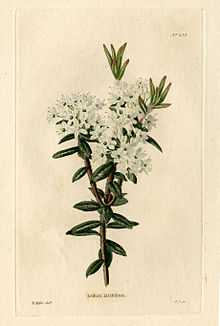Labrador tea


Labrador tea is a term used to describe the herbal tea (not a true tea) made from three closely related species, as well as the species themselves:
- Rhododendron tomentosum (Northern Labrador tea, previously Ledum palustre),
- Rhododendron groenlandicum, (Bog Labrador tea, previously Ledum groenlandicum or Ledum latifolium) and
- Rhododendron neoglandulosum, (Western Labrador tea, or trapper's tea, previously Ledum glandulosum).
All three are primarily wetland plants in the Heath family (Ericaceae). The herbal tea has been a favorite beverage among Athabaskan and Inuit people for many years.
Description
All three species used to make Labrador tea are low, slow-growing shrubs with evergreen leaves. The leaves are smooth on top with often wrinkled edges, and fuzzy white to red-brown underneath.
Uses
The Athabaskans brew the leaves as a beverage and some people chew the raw leaves because they enjoy the flavor. Others use Labrador tea to spice meat by boiling the leaves and branches in water and then soaking the meat in the decoction.
The Pomo, Kashaya, Tolowa and Yurok of Northern California boiled the leaves of Western Labrador Tea similarly, to make a medicinal herbal tea.[1] In Greenland, this is still the case. Here it is also used in facial steam bath.
In medieval Northern Europe, R. groenlandicum and R. tomentosum were often brewed in "gruit" ales, prior to the adoption of hops.
Labrador tea contains ledol, a poisonous substance that can cause cramps and paralysis.
Toxicology
Labrador tea has narcotic properties. Evidence suggests that excessive consumption of the plant may cause delirium or poisoning. Toxic terpenes of the essential oils cause symptoms of intoxication, such as slow pulse, lowering of blood pressure, lack of coordination, convulsions, paralysis, and in rare cases death. It is apparently safe as a herbal tea, but should not be taken in large quantity. [2]
Habitat
Rhododendron tomentosum grows in peaty soils, shrubby areas, moss and lichen tundra.
Rhododendron groenlandicum grows in bogs and wet shores, and sometimes on rocky alpine slopes. Both species are generally northern (north temperate to tundra) in distribution, with the range of R. groenlandicum somewhat farther south.
Rhododendron neoglandulosum grows in wetlands and bogs in western North America, from British Columbia to California to Colorado.
Harvesting
Rhododendron tomentosum, Rhododendron groenlandicum, and Rhododendron neoglandulosum grow slowly, so pick individual leaves rather than whole branches, and harvest from different shrubs. In addition, Labrador tea grows in abundance in large patches so it should not be difficult to move from plant to plant to avoid over-harvesting. Labrador tea is an evergreen plant and will be available all year long.
External links
References
−